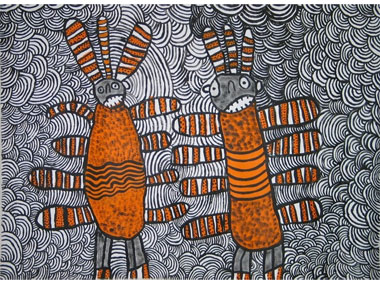Monstrous figures in Arnhem Land

Nura Rupert, Australia, c.1933. Pitjantjatjara people, South Australia, Mamu (Spooky spirits) 2006, Ed and Sue Tweddell Fund for SA Contemporary Art 2006. Art Gallery of South Australia, Adelaide © Nura Rupert, courtesy of Ernabella Arts
Aboriginal Art Directory | 04.05.14
There's some impressive writing going on at The Conversation at present - and that's not only from the contributors, check out the feedback as well. The following is an excerpt from Christine Nicholls' latest, Monstrous figures in Arnhem Land, the 5th part in a series which sheds light on Aboriginal Dreamings.
As in the case of the desert regions, the repertoire of monstrous figures in Arnhem Land in the wet tropical monsoon-prone far north of Australia, speaks to the inherent dangers of particular environments. This is also reflected in artworks and narratives.
At one level, Yawk Yawks could be described as Antipodean mermaids – except for the fact that they are not benign. These fish-tailed maidens, young women Spirit Beings, with long flowing locks of hair comprised of green algae, live, or perhaps it would be more accurate to say “lurk”, in the deep waterholes, rockholes and freshwater streams of Western Arnhem Land in particular.
Children and young people particularly fear them, because they are believed to be capable of dragging people underwater and drowning them. Like most Aboriginal Spirits, they have the capacity to metamorphose, and can sometimes assume a presence on dry land, before morphing back into water spirits.
There are a number of celebrated artist-exponents of Yawk Yawks in Arnhem Land, including Luke Nganjmirra, a Kunwinjku painter working from Injalak Arts & Crafts, Maningrida-based brothers Owen Yalandja and Crusoe Kurddal (carvers), the sons of the late Kuninjku ceremonial leader Crusoe Kuningbal (1922-1984), and Anniebell Marrngamarrnga (a weaver who fashions Yawk Yawk maidens from pandanus) who also works with the Maningrida Arts and Cultural centre.
Also in Arnhem Land are Namorroddo Spirits.
They have long claws and at night fly through the air, long hair streaming, to prey on human victims. Parents control children by cautioning them not to run around outside at night, particularly when there is a high wind, which echoes the sound that the Namorroddos make as they whistle and swish though the night sky, their skeletal bodies held together only by thin strips of flesh.
Namorroddos are somewhat akin to vampires, in that they suck out their human victims’ life juices, after killing them first by sinking their long sharp claws into them. In turn, their victims are also transformed into Namorroddos.
And sorcerers abound, none more feared than the Dulklorrkelorrkeng, genderless, or rather, capable of assuming the characteristics of either gender, malignant Spirit Beings with faces similar to those of flying foxes, and that eat poisonous snakes with relish - to no ill effect.
Dulklorrkelorrkeng are known to go around with a whip snake tied to their thumbs, and they live in forests that have no ground water. In many respects they resemble the Namande spirits of western Arnhem Land. The late Arnhem Land artist Lofty Bardayal Nadjamarrek, of the Kundedjinjenghmi people, was esteemed as possibly the greatest living limner of the sorcerer-spirit Dulklorrkelorrkeng.
This account given here barely touches the surface of this vast topic. It points nevertheless to the extensive reach of Aboriginal Dreamings, culture, and visual art, which have the capacity to portray every aspect of human life, and the lives of other species too.
Ultimately, these Monstrous Beings and their narratives serve a critically important social function that contributes to the maintenance of life: that of instilling into young and old alike a healthy respect and commensurate fear of the specific dangers, both environmental and psychic, in particular places.
Read the full article at The Conversation
About Christine Nicholls
Dr Christine Nicholls is a writer, curator and Senior Lecturer in Australian Studies at Flinders University. She is well published in the fields of visual art, linguistics, and education (particularly Indigenous Australian languages and Indigenous Australian artistic practice, as well as Indigenous education) and has published more than twelve books, all of which have won significant prizes (for example, Kathleen Petyarre: Genius of Place, co-written with Ian North, and published by Wakefield Press, and one of the earliest publications in the SALA series, won The Art Association of Australia and New Zealand publication Prize for the Best Visual Art Book published in the region, in 2001).
Among Christine’s more recent publications is the framing essay Painting Alone in Yulyurlu: Lorna Fencer Napurrurla, published by Wakefield Press in 2011, and EarthWorks, and overview of the history of Indigenous Australian ceramics, which is accompanied by a book that she has written on that history of Indigenous ceramics.
Share this:
»  del.icio.us
»
del.icio.us
»  Digg it
»
Digg it
»  reddit
»
reddit
»  Google
»
Google
»  StumbleUpon
»
StumbleUpon
»  Technorati
»
Technorati
»  Facebook
Facebook
Contact Details
Further Research
News Archive
- 11.10.17 | RETURN OF MUNGO MAN
- 10.10.17 | TARNANTHI 2017
- 11.08.17 | Natsiaas 2017
- 08.08.17 | ABORIGINAL ART ECONOMICS
- 02.08.17 | SCHOLL'S NEXT MOVE
- 20.07.17 | APY ART DOMINATES THE WYNNE
- 17.07.17 | Anangu Artist Wins $100,000 Prize
- 14.07.17 | The End of AAMU
- 13.07.17 | YOU ARE HERE
- 11.07.17 | ART ACROSS THE COUNTRY
- 11.07.17 | TARNANTHI IN OCTOBER
- 05.07.17 | TJUNGUṈUTJA - from having come together
- 02.07.17 | BENNELONG
- 27.06.17 | JIMMY CHI
- 23.06.17 | Blak Markets at Barangaroo
Advertising

